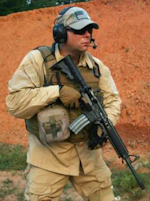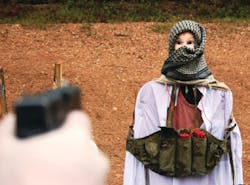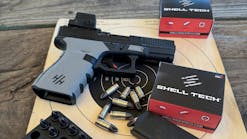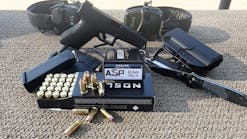You are off-duty/plain clothes and armed, you pick the scenario: restaurant, shopping mall, church, etc. Johnny Jihad walks in and starts indiscriminately shooting up the place. This isn’t the square range with twenty foot dirt berms on three sides where there are nothing but you and a cardboard target. Our in the world there are more folks running around that should not be shot than those who should. If you are a copy you can’t just hide and call 9-1-1. Failure to act on your part would be a death sentence to innocent citizens or your family. Are you ready for the test?
The basic premise for The Red Zone, a one day class I recently attended in Camden, Tennessee was that during an actual life or death encounter there are far more things that should not be shot than those than should be. Johnny Jihad is evil and can shoot up the landscape. You are the good guy and cannot do so. David Biggers former U.S. Army Officer and dedicated student of the gun led a dozen men and women through several drills designed to force the shooter to fire their defensive pistols in a deliberate and discriminating manner.
Up Close and Personal
The FBI compiles the most thorough statistics of actual gunfights in the United States. According to the 2009 stats, 19 of the 48 officers murdered in the line of duty where a firearm was used were 0-5 feet from their attacker. We’ve all accepted the 21 foot average, but the truth seems to be that 21 feet is more likely to be the outer limit than the minimum.
When I attended the police academy some two decades back the preferred method for teaching up close shooting was the “Speed Rock”. Officers standing at arm’s length from the target would draw from their duty rig while simultaneously ‘rocking’ their upper torso backward. The shot would be fired from the hip level. This technique looked ‘totally ninja’ when performed correctly and worked great against cardboard.
Along came Simunitions and other Force on Force gear in the late 1990’s and we discovered that the Speed Rock more often than not ended with the good guy on his back and the bad guy onto of him. The Speed Rock puts you off balance and even a small person can topple you onto your butt. Sure, he might bleed to death in ten minutes but that won’t stop him from stabbing you twenty times before he does.
A more practical method for bad breath range is to widen your platform for better balance guard your head with your support side arm, draw your weapon and fire at a downward angle while keeping the gun tight against you torso and away from the attacker’s hands. The fraction of a second after the gun is drawn and the shot fires the defender attempts to create space by moving backwards. Be honest, when is the last time you fired while moving backward?
You may find yourself with your gun out to cover a suspect and be hit by a lunging attack. Now your attacker has your pistol pinned in between your body and his pushing the slide out of battery. We all know that pushing the slide less than a half inch takes the gun out of battery and keeps it from firing. During the Red Zone course we practiced gripping our pistols so that the slide was forced to remain locked and in battery while making a contact shot. Our target for this was a heavy bag.
Working the Angles
After spending an hour or so working up close and personal, Mr. Biggers set up target scenarios that included Shoot/No Shoot cardboard silhouettes drape in t-shirts. Unlike many range scenarios where the Shoot/No Shoot targets are lined up next to each other horizontally, Dave stacked them together in a three dimensional fashion, just as they would be in the real world.
Sometimes the bad guy would be in front of several “no shoots”, sometimes it would be behind them or mixed in the center. The point of the drill was to force the shooter to move into a position to minimize to the greatest extent a pass through shot from the bad guy to a good guy. It was a tough drill, especially for folks used to simply shooting silhouettes.
During a following drill shooters had to move into a position to shoot and negotiate around friendly/no shoot targets without covering them with the muzzles of their guns. Imagine that you and several other officers are on scene. You need to get a shot on the bad guy but your partner is unknowingly in the way. It’s poor form and dangerous to simply sweep them with your muzzle. Muzzle aversion is the fancy term for pointing your gun either up or down to avoid negligently shooting a good guy. The trick with practicing muzzle aversion is to avert and come right back up on target and make the shot. If you’ve never practiced this on the training range you are setting yourself for failure on the street. Remember, we don’t “rise to the occasion” under life and death stress. Instead we will default to the level of skill that we have mastered during training and practice.
The Ubiquitous Head Shot
We talk about it a lot and practice on cardboard and paper silhouettes but the head shot is tougher than most officers imagine. Humans are not made of cardboard. When God made you he protected the important stuff with bone. Ask a veteran street cop and he’ll regale you with tales of street people who were shot in the head and walked away from it.
For this drill Dave tapped into the local beauty college and picked up their used “heads” at a discount price. These rubber manikin heads absorbed FMJ bullets very well. That is the bullets passed right through them doing minimum damage.
For the last few drills target bodies were topped with the human looking heads. From varied distances and angles shooters had to move on the targets and make a fight stopping head shot. The graduation exercise of sorts was the “suicide bomber”. Students were tasked with putting a single round through the ocular cavity from seven yards to “shut down” the bomber. Again, it was a tough shot.
Parting Thoughts
If your firearms training goes no farther than simple marksmanship or completing a semi-annual qualification course you are cheating yourself. Those who must rely on firearms to save their lives and those of the innocent should possess more than the fundamentals. The square range is not the real world. In the real world there are far more things that should not be shot than should be. Reality can be harsh, get some training and learn to deal with it.
Web Links:
About The Author:
Mr. Markel is a former United States Marine, Police Officer, and has worked as a professional bodyguard both in the U.S. and overseas. A Subject Matter Expert on Small Arms and Tactics, Markel has provided instruction to law enforcement and U.S. Military troops.
As a recognized author and writer, Paul has penned several hundred articles published in numerous professional journals and trade periodicals. Topics include firearms training, use of force, marksmanship, less-than-lethal force options, product reviews and evaluations, emergency medical care, and much more. Sought after as a public speaker, Mr. Markel is at home in front of an audience large or small.

Paul Markel
Mr. Markel is a former United States Marine, Police Officer, and has worked as a professional bodyguard both in the U.S. and overseas. A Subject Matter Expert on Small Arms and Tactics, Markel has provided instruction to law enforcement and U.S. Military troops.
As a recognized author and writer, Paul has penned several hundred articles published in numerous professional journals and trade periodicals. Topics include firearms training, use of force, marksmanship, less-than-lethal force options, product reviews and evaluations, emergency medical care, and much more. Sought after as a public speaker, Mr. Markel is at home in front of an audience large or small.
Follow Mr. Markel's instructional show: http://www.studentofthegun.com



